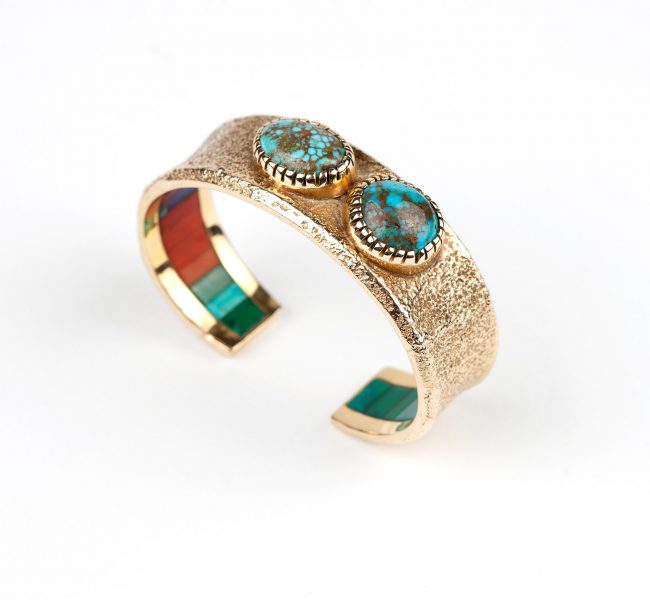When John Moran started his auction business fifty years ago, he created a workplace that celebrated the beauty in our world, from exceptional design to beautiful works of art to good deeds. His business would grow to become one of the most respected auction houses in the country. From almost the beginning—before many in the industry took notice—that business included the burgeoning market for American Indian and Western objects and works of art. The Southwest, imbued with the history of Native peoples and the nostalgia of the Old West, captured John’s imagination, and he would take yearly trips to the region.
“This appreciation developed into a passion that would last throughout his life and forge the long-standing American Indian and Western departments Moran’s is known for today. With sales in excess of two million dollars, Moran’s has become a leading force in the sale of American Indian and Western objects and art in the United States.”

A California Mission Cahuilla snake basket Price Realized: $6,600
In 2012, a man walked into Moran’s offices with a blanket that had been in his family for over 150 years. It was hand-woven with alternating bands of indigo, red, and natural cream and brown wool in a perfect balance that seemed to glow and John knew this was something special. Created around 1840, the blanket was one of the rarest of the rare Navajo weavings, a First Phase chief’s wearing blanket with bayeta bands. After a protracted bidding war, the blanket shattered the previous 22-year-old auction record for a Navajo textile ($522,000), selling for an unprecedented $1,800,000 (all prices realized include the buyer’s premium).

A Navajo Chief’s Blanket, First Phase
After that success, Moran’s has handled several more Classic-period wearing blankets. A Second Phase example, with its characteristic patterns of rectangles woven into the bands, was sold by Moran’s during their November 2017 auction, bringing $48,000. By the Third Phase of the Classic period of Navajo weaving, the broad linear stripes of the First Phase blankets evolved to incorporate diamond designs throughout the center and all four corners of the blanket. A stunning Third Phase weaving will be offered in Moran’s upcoming Art of the American West auction on September 8th.

A Visalia Stock Saddle Co. parade saddle adorned with silver conchos
In addition to fine weavings and basketry, Moran’s has handled many pieces of American Indian jewelry and Western craft over the years. Charles Loloma, one of the most important jewelers of the 20th century, found his passion and inspiration in jewelry making in the 1950s and would come to re-define and re-interpret Native and non-Native designs in his work. A 14k yellow gold bracelet set with two turquoise cabochons to the top and channel-set with tablets of turquoise, lapis lazuli, and coral to the interior was a masterclass in balance and design and brought $21,250 when it sold at auction. A Visalia Stock Saddle Co. parade saddle adorned with silver conchos and expertly tooled leather in a golden poppy motif, the California state flower, brought a stellar $24,000 at auction. Famed Hollywood-based craftsman and silversmith Edward H. Bohlin created pieces that adorned Western stars, stuntmen, and cowboys for generations. A gorgeous sterling silver and ruby belt buckle with the iconic-motif brought $2400.

A Hopi gold cuff bracelet, Charles Loloma Price Realized: $21,250.00
The spirit of the West as it was and as it is today is perhaps illustrated best by the brush of an artist. Moran’s has handled major works from Edward Borein to Joseph Henry Sharp to Bill Anton and many more. “Desert Skies” from Los Angeles-based artist Edgar Alwin Payne is the quintessential Southwestern scene. The cowboys in shadow in the foreground follow the trail towards the scenic bluffs under grand white clouds in the background, and the superb work brought $316,250 when it sold at auction. A contemporary work from Tucker Smith of two cowboys herding cattle preserves a day in the life of the modern cowboy. The work was consigned from the collection of Phoebe Hearst Cooke, an avid collector of contemporary Western art, and brought $45,000. An Armin Carl Hansen oil, “Bronco Busters, Salinas Rodeo,” transports the viewer to the dusty, controlled chaos of the rodeo and realized $102,000 at auction. Anna Katherine Skeele, a student of Armin Carl Hansen and an artist local to Moran’s headquarters in Monrovia, California, spent many summers living at the Taos Pueblo. “Pueblo Life, Taos” focuses on the women of the Pueblo going about their everyday lives. The vibrant painting in a stylized modernist aesthetic set an auction record for her work when it sold for $45,000.

Anna Katharine Skeele (1896-1963 Monrovia, CA) ”Pueblo Life, Taos” Price Realized: 45,000.00
John found beauty in the coils of a basket, the wefts of a wearing blanket, and in the brushwork rendering red bluffs in shadow. The firm he founded carries on his legacy with annual dedicated sales celebrating the spirit and peoples of the West, realizing strong prices for our consignors and adding to the carefully curated collections of our buyers. Our upcoming September 8th Art of the American West auction is filling fast with important Navajo textiles, iconic hand-colored prints from Karl Bodmer, and many more works of art from the old and new West. See what Moran’s has to offer at our website jm.dev.hookson1.com or give them a call at 626-793-1833, there will always be a friendly face at the end of the trail.

